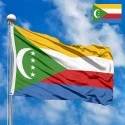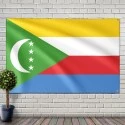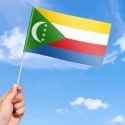The national flag of the Union of the Comoros is a striking and deeply symbolic emblem that encapsulates the nation's rich history, its Islamic faith, its four main islands, and its aspirations for unity and prosperity. Adopted on January 7, 2002, this flag is the most recent in a series of designs that have evolved since the archipelago gained independence from France. Its vibrant colors and unique arrangement reflect a conscious effort to represent all facets of Comorian identity and the peaceful coexistence of its diverse population.
Design and Symbolism: A Tapestry of Island Identity and Islamic Faith
The flag of the Comoros features four horizontal stripes of yellow, white, red, and blue from top to bottom, with a green triangle on the hoist side. Within the green triangle are a white crescent moon pointing towards the fly and four white five-pointed stars vertically aligned between the points of the crescent. Each element carries profound meaning:
-
Horizontal Stripes:
-
Yellow (Top Stripe): Represents the island of Moheli (Mwali). Yellow also traditionally symbolizes the sun, warmth, and a bright future, reflecting the hope and vibrancy of the Comorian people.
-
White (Second Stripe): Represents the island of Mayotte (Mahore). Mayotte remains a French overseas department, but the Comoros claims sovereignty over it. Including white on the flag is a clear assertion of this claim and a desire for eventual unity. White also commonly symbolizes peace and purity.
-
Red (Third Stripe): Represents the island of Anjouan (Nzwani). Red is a powerful color, often associated with the sacrifices made for independence and the nation's determination.
-
Blue (Bottom Stripe): Represents the island of Grande Comore (Ngazidja). Blue is also a traditional color for the Indian Ocean, which surrounds the islands, signifying the sea and the sky, and by extension, the nation's natural environment and its maritime heritage.
-
Green Triangle: The prominent green triangle on the hoist side is a direct reference to Islam, the predominant religion in the Comoros. Green is considered the traditional color of Islam, symbolizing hope, paradise, and life. Its triangular shape also points forward, suggesting progress and aspiration.
-
White Crescent Moon: The white crescent moon is another powerful symbol of Islam. Its orientation, pointing towards the fly, is characteristic of many Islamic flags and signifies the nation's adherence to its faith. White, as always, adds the element of peace and purity to this religious symbol.
-
Four White Stars: The four white five-pointed stars, vertically aligned within the crescent, represent the four main islands of the Comoros archipelago:
-
Grande Comore (Ngazidja)
-
Anjouan (Nzwani)
-
Moheli (Mwali)
-
Mayotte (Mahore) (even though Mayotte is administered by France, its inclusion on the flag reaffirms the Comorian claim). The stars symbolize the light and guidance provided by the islands, shining brightly in unity. Their white color further emphasizes peace and purity.
The overall design is a sophisticated blend of geographical, cultural, and religious symbolism, meticulously crafted to represent the unity and aspirations of the Comorian people across their archipelago.
Dimensions and Proportions:
The official proportions of the Flag of the Comoros are a width-to-length ratio of 2:3. This is a common and practical ratio for many national flags. The four horizontal stripes are of equal width. The green triangle extends from the hoist to approximately two-fifths (or two-thirds, depending on interpretation of official and de facto usage) of the flag's length, with its base along the entire height of the hoist side. The crescent and stars are proportionally placed within the triangle to ensure their visibility and balance. The precise dimensions are codified to maintain the integrity of the design and its rich symbolism.
History and Evolution: A Reflection of Political Changes
The flag of the Comoros has undergone several significant changes since the nation's journey towards independence, reflecting its complex political history and the ongoing aspiration for unity among its islands.
-
Pre-Independence (French Colonial Era): Before gaining independence, the Comoros used the French Tricolour.
-
First Flag (1975-1978): Upon declaring independence in July 1975, the Comoros adopted its first national flag. This flag featured a plain green field with a white crescent and four white stars arranged in a diamond pattern in the center. Green and the crescent symbolized Islam, and the four stars represented the islands. This flag was in use during the short-lived First Republic under Ahmed Abdallah.
-
Second Flag (1978-1992): Following a coup and the re-establishment of a federal Islamic republic, a new flag was adopted in 1978. This design was similar to the first, but the stars were arranged in a more linear fashion below the crescent, and the green field was retained. This flag symbolized the continuity of the Islamic identity while subtly adjusting the representation of the islands.
-
Third Flag (1992-1996): In 1992, a new constitution was adopted, leading to another flag change. This version featured a green field with a large white crescent at the center, flanked by four white stars. The arrangement of the stars around the crescent varied slightly from previous versions.
-
Fourth Flag (1996-2001): Another flag was introduced in 1996, retaining the green field and the crescent and stars, but often with the stars arranged vertically within the crescent. This period was marked by secessionist movements, particularly from Anjouan and Moheli, seeking greater autonomy or independence from the federal government. The frequent flag changes during this turbulent era reflected the political instability.
-
Current Flag (2002-Present): In response to the persistent secessionist crises and the need for a more inclusive symbol, a new constitution was adopted in 2001, leading to the creation of the current flag on January 7, 2002. This design was a radical departure from previous green flags, introducing the four horizontal stripes representing each island individually. This was a crucial step towards explicitly recognizing the distinct identities of the islands within the Union and acknowledging their unique positions, aiming to foster greater unity and stability. The green triangle and the crescent and stars were retained as overarching symbols of the nation's Islamic faith and its four component islands, unifying the new design.
The current flag, therefore, is a powerful statement of a nation striving for unity and acknowledging the diverse identities of its constituent parts, a direct result of historical challenges and a commitment to a peaceful, unified future.
Regional Context and East African/Indian Ocean Identity:
The Comoros are an archipelago nation situated in the Indian Ocean, off the eastern coast of Africa, between Madagascar and Mozambique. This geographical position places it at a crossroads of African, Arab, and Indian cultural influences, all of which have contributed to its unique identity.
Within the East African and Indian Ocean region, the Comorian flag stands out with its explicit representation of four islands and its strong Islamic symbolism. Many flags in this region often feature colors associated with Pan-Africanism (red, yellow, green, black) or reflect diverse colonial legacies. The Comorian flag, however, prioritizes its archipelagic nature and its dominant religion. The use of a crescent moon and stars is common among flags of Islamic nations globally, but the Comorian flag uniquely combines this with the four distinct horizontal stripes for its islands. This distinctiveness reinforces the Comoros' sovereign identity and its blend of African heritage, Islamic faith, and island geography within the broader Indian Ocean context. The ongoing claim to Mayotte, symbolized by the white stripe, also makes it a unique flag in terms of its territorial claims within the region.
Interesting Facts:
-
Four Islands, Four Colors: The flag is one of the few in the world where each major horizontal color stripe specifically represents a distinct island (Moheli, Mayotte, Anjouan, Grande Comore).
-
Claim to Mayotte: The white stripe and one of the four stars explicitly represent Mayotte, an island that remains an overseas department of France but is claimed by the Comoros. This territorial claim is visually embedded in the national symbol.
-
Multiple Flag Changes: The Comoros has had more flag changes since its independence in 1975 than many other nations, reflecting its turbulent political history, particularly the numerous coups and secessionist movements.
-
Islamic Symbolism: The green triangle, white crescent, and stars are strong symbols of Islam, which is the predominant religion in the Comoros.
-
"Moon Island": The Comoros are sometimes referred to as "Moon Islands" (derived from the Arabic word "qamar" meaning moon), a poetic connection to the crescent moon on their flag.
-
Unique Star Arrangement: The vertical alignment of the four stars within the crescent is a distinctive feature, rather than a more common circular or scattered arrangement.
-
Designed for Unity: The 2002 flag was specifically designed to promote unity and reconciliation among the islands after periods of secessionist conflicts, by giving each island its own color on the flag.
-
An Archipelago Nation: The flag powerfully communicates the nation's identity as an archipelago, with each island being a distinct but integral part of the whole.
-
Indian Ocean Location: The blue stripe can also be interpreted as representing the surrounding Indian Ocean, which is vital to the country's economy and way of life.
-
Pan-Africanism Absence: Unlike many other African flags, the Comoros flag does not use the traditional Pan-African colors (red, yellow, green, black) in its primary design, instead opting for a unique palette with island-specific and religious symbolism.
Significance for the Inhabitants: A Banner of Unity, Faith, and Island Pride
For the people of the Union of the Comoros, their national flag is an extraordinarily potent symbol, imbued with layers of meaning that resonate deeply with their daily lives, their historical struggles, and their collective aspirations. It is a source of immense pride, representing not just the nation-state, but the very essence of their island identity and their shared destiny.
The most striking aspect of the current flag is its explicit representation of each of the four main islands through distinct horizontal stripes. For the inhabitants, this is a powerful affirmation of their individual island identities within the larger Comorian nation. It is a visual promise of recognition and inclusion, a direct response to past periods of secessionist tensions. Whether one hails from Grande Comore, Anjouan, Moheli, or even Mayotte (whose inclusion, despite French administration, is a constant reminder of the Comorian claim), the flag speaks to their belonging and the nation's desire for an encompassing unity. This design helps to foster a sense of collective ownership and reduces feelings of marginalization that some islanders may have experienced historically.
The green triangle and the white crescent and stars further reinforce the strong bond of Islamic faith that unites the vast majority of Comorians. Islam is not merely a religion; it is a fundamental pillar of their culture, their legal system, and their social fabric. The flag proudly displays this shared heritage, reminding citizens of their common values and the spiritual guidance that underpins their society. The stars, representing the islands within the embrace of the crescent, symbolize a divine blessing and protection over the archipelago, reinforcing a sense of common destiny under God.
Furthermore, the flag embodies the nation's aspirations for peace and prosperity. The white elements signify peace and purity, crucial values for a nation that has known political instability. The vibrant colors evoke the natural beauty of their islands – the blue of the surrounding ocean, the yellow of the sun, the red of passion, and the green of the land and hope for the future.
Ultimately, for Comorians, the flag is a living narrative of their journey: from colonial rule to independence, through periods of division, and towards a future of unified self-determination, all guided by their faith. It is a rallying point, a source of collective memory, and a constant reminder that despite their geographical dispersion, they are one people, bound by shared islands, a common faith, and a collective dream of a harmonious and prosperous Comoros. Displayed during national celebrations, in homes, and on public buildings, the flag is a powerful emblem of their unique place in the world and their unwavering spirit of resilience and unity.
In the demonstration images, full-size flags are shown with proportions of 2:3, and hand-held flags with proportions of 1:2.






 Waving flag
Waving flag
 Sizes:
Sizes:
 Round flag
Round flag
 Sizes:
Sizes:
 Rectangular flag 2:3
Rectangular flag 2:3
 Sizes:
Sizes: